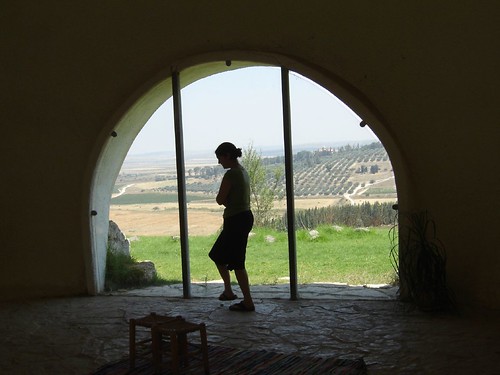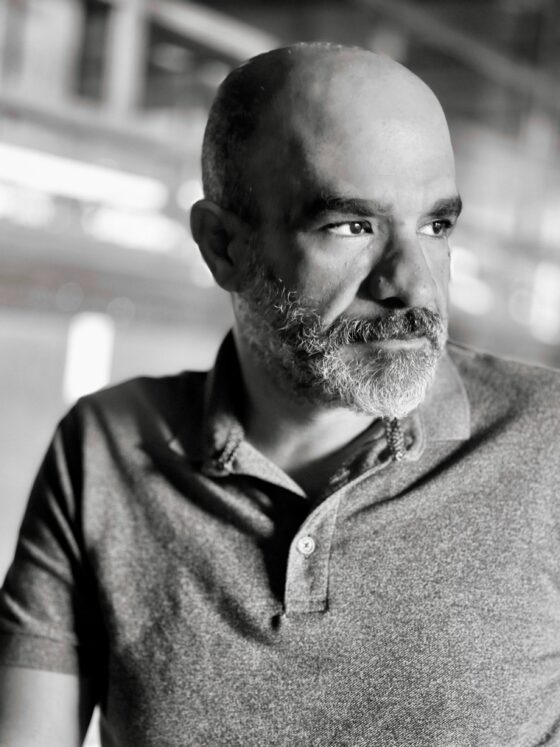A Three Part Interview Roundtable
Part 3 – Rayek Rizek

Rayek Rizek came to Neve Shalom (a village on the green line madated 50 percent Israeli Jew and 50 percent Palestinian Arab) with his wife Dyana in May 1984 and has served as mayor twice. These days, Rizek runs a Café and a shop with his wife, located near the community’s guesthouse.
JN: What has changed about the community as it has expanded? Is expansion good for the village?
Rayek Rizek: With the growth of the Alwaha, it has changed from a community to a village. This means that people here are less in contact with each other. Fewer and fewer people come to the General meeting or are willing to take the responsibilities of being members in the different committees. A majority of inhabitants now work outside of the Village and many of the internal issues are not of interest to them.
So it seems that the more the Community grows the lesser the contact between the people as a whole group. But also people group around different issues. For example, those who still have kids in the school are more interested in what is taking place in this institution than those who do not have kids there. Those who are working in the village and are paid by it are more present in the budget meetings than those who do not work in the Village. Also, people are socializing in small groups that are mostly mixed between Jews and Palestinians and not anymore in the whole group as when it was a community of twenty families.
This is not to say that what has been happening is a failure. The community is still growing and I believe it is more legitimate as an idea than it has been ever been in the country. This is a general and short answer for a complex question.
JN: Where does NSWAS’s confidence in co-existence come from?
RR: Since the idea of NSWAS required its members to also live together in the same place the experience has been different. The community became the home of its members and therefore it made it more difficult to quit. But every single person here has thought many times about leaving as a result of different disappointments and contradicting expectations. But when the moment to make that final decision comes close, it appears to be more difficult to consider such a step since it was not about quitting your membership in an organization but more about physically loading your belongings and yourself to go to some other place.
I always say that we were stuck together here like a group of people on a boat at the middle of the sea where you do not have any other choice except to continue the journey. You cannot make a hole in your part of the boat since you will drown everybody else with you and you have to work together with the rest if you are to face the storm. I believe that peace between our two peoples will be more possible when they both develop this awareness of being on the same boat for good or bad.
JN: When I first came to Wahat al-Salam I carried with me this sense that I’d found the perfect peaceful utopia. All of the members I talked to quickly relieved me of this myth, pointing out that life in an intentional community is as messy and intense as life anywhere else. Maybe more so. Eventually my disillusionment evolved into a sense of respect for the work the community does. One of the hardest examples of Neve Shalom “living the conflict” was in regards to the death of native son Tom Kita’in.
RR: Tom was killed in an accident between two Israeli Defense Forces Helicopters along with another 75 soldiers who were in their way to Lebanon. The death of Tom was a big shock for the whole village. All of us, Jews and Palestinians, joined the family in their pain and took part in the funeral. This funeral was for most if not all the Palestinians the first funeral to be attended for an Israeli soldier. But in this case it was the funeral of a young man from the village who was also the son and the brother of a family that had been among us for more than ten years.
The sad situation was when the Israeli journalists were obsessed with trying to find out about the feelings of the Palestinian members. They wanted to be sure we really were also in pain for the death of the soldier. What those journalists were looking for and hoping for was proof that the whole idea of NSWAS is a fake.
 Anyway, some months passed by and an idea came up with the suggestion of erecting a monument for Tom at the entrance of the newly finished basketball field in the village. The idea was not accepted by most of the Arab members (joined by some Jewish members) who still saw Tom as a soldier who was involved in fighting against the Lebanese and maybe the Palestinian resistance in Lebanon. We carried many meetings and we could not reach an agreement. After months of discussions I suggested hanging a plaque near the entrance of the field with a tree to be planted under it. The content of words on the plaque would be left for the family to decide. And then it was over. I cannot say that every body agreed with my idea but that was a solution that everybody could live with.
Anyway, some months passed by and an idea came up with the suggestion of erecting a monument for Tom at the entrance of the newly finished basketball field in the village. The idea was not accepted by most of the Arab members (joined by some Jewish members) who still saw Tom as a soldier who was involved in fighting against the Lebanese and maybe the Palestinian resistance in Lebanon. We carried many meetings and we could not reach an agreement. After months of discussions I suggested hanging a plaque near the entrance of the field with a tree to be planted under it. The content of words on the plaque would be left for the family to decide. And then it was over. I cannot say that every body agreed with my idea but that was a solution that everybody could live with.
JN: In 1999 a Mr. Shlomo Mark argued in the Jerusalem Post that the divisions surrounding the death of Kita’in proved that NSWAS had been “tried in tragedy” and “found wanting.” You wrote a letter published in the Post on March 26, 1999.
RR: In spite of our resolution with the plaque, the Israeli press still insisted on talking about the unneeded compromise which was made by the Jews and about the so-called insensitivity of the Palestinian families. But this was not true since we made a difficult and challenging choice of living together while still being part of the conflict. I said before that the encounter here was with no preconditions and therefore everything is expected and every argument and disagreement is legitimate. After all we are the only group in all of the Jews and Palestinians who took this challenge and who are dealing with the most difficult questions that nobody else is dealing with. And you have to remember that we are not a group of professionals in conflict resolution but we are ordinary people who made a choice to live a very real challenge.
JN: What is it like in the community on May 14, the day that Israeli Jews view as Independence Day and Palestinian Arabs view as “the catastrophe”?
RR: The relation to this issue has changed with the times. It was only during 1984 when the demographic balance between Jews and Palestinians reached equality as a result of the absorption of three Palestinian families including myself and Dyana. So the first Independence/Nakba occasion that raised a serious discussion was that spring, in 1984. I would say that the presence of almost an equal number of Jews and Palestinians brought many serious discussions about the identity of the community. It was also in September 1984 when the primary school was opened which was another important issue to be discussed, regarding the question of bilingual, bi-national and multi cultural education, since there were Jewish, Moslem Arab, and Christian Arab kids in the school. I still remember that during those early discussions regarding the issue of Independence/Nakba things were not easy. From one side the Jews felt that it would be okay to celebrate the independence and believed that there was no contradiction between their choice to live in NSWAS and also to celebrate. It became clear for most of them and maybe for the first time that the Palestinians will not feel easy with this celebration since the occasion has a totally different meaning to us.
This was one of those issues that was not possible to solve with a vote at the end of a meeting. But what became clear for everybody was that this day was an occasion that we cannot be together around. Those intensive meetings helped us to understand the complexity of our choices without necessarily reaching agreements. It was common to see members from the same national group arguing with each other since they had different opinions or different levels of tolerance towards what a certain member from the other group could express of feelings and needs. With time we got so used to this situation. During the occasion of Independence some Jewish families would get together on that evening to fry some food on a fire and to sing as they were used to doing outside. Some of them would raise the flag on the Balcony of their house. Today nothing happens here. No gatherings or celebrations or flags. It seems that most of the Jews have made a certain compromise regarding the celebration of this day in the village.
JN: Are you optimistic about the prospects for peace in, say, your lifetime?
RR: I don’t want to put a time frame on it. I chose to live in a bi-national ideological community like NSWAS because I didn’t want to wait around for the leaders to make peace. I live as if the future is now.
(read part 1 here, read part 2 here) (we published 6,000 words of this round table in three parts. download the complete 11,000 word transcript as a pdf)
**




